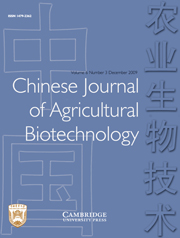No CrossRef data available.
Article contents
Cloning and nucleotide sequence of the cDNA encoding a β-1,3-glucanase-like protein secreted from growing pollen tubes of Japanese pear (Pyrus pyrifolia)
Published online by Cambridge University Press: 12 February 2007
Abstract
A pollen cDNA library of Japanese pear (Pyrus pyrifolia) from the family Rosaceae was constructed and a cDNA (bgn-1) of 1408 bp, which encodes a protein (BGN-1) secreted from growing pollen tubes, was cloned and sequenced. bgn-1 cDNA is composed of a 5′-untranslated region of 47 bp, an open reading frame of 1194 bp encoding 397 amino acid residues and a complete 3′-untranslated region of 167 bp. Alignment of the deduced amino acid sequence of bgn-1 with that of barley (Hordeum vulgare) β-1,3-glucanase (GII) showed 39.7% amino acid identity. Several residues that were critical for the function of GII were conserved in the deduced BGN-1 polypeptide. Moreover, hydrophobic cluster analysis (HCA) showed an overall HCA homology score of 87.1% and analysis of BGN-1 with the 3D-PSSM program predicted a three-dimensional structure of BGN-1 highly homologous to that of barley GII with ≥95% certainty. These results suggest that the cloned bgn-1 cDNA encodes a β-1,3-glucanase-like protein in Japanese pear. The predicted mature protein (375 amino acids) has a theoretical molecular mass of 40 723 Da, a basic pI of 9.59 and a diagnostic amino acid residue mode of D, L, S and L, which is very similar to that of growth-related subfamily D (D, L, S and Q) in cereals. A ProXXPro repeat is also found between positions 352 and 367 in the C-extension region.
Information
- Type
- Research Article
- Information
- Copyright
- Copyright © China Agricultural University and Cambridge University Press 2005

